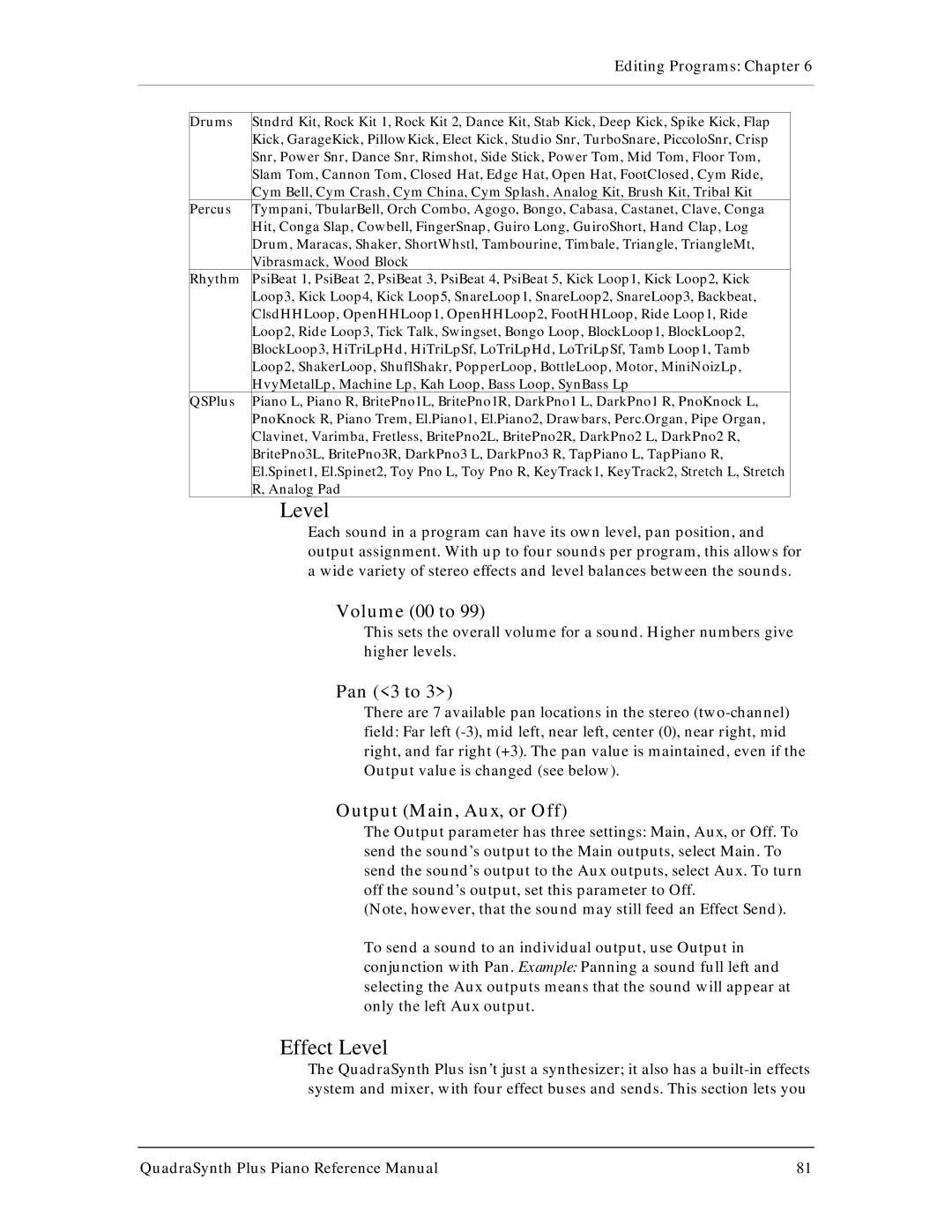|
| Editing Programs: Chapter 6 | |
|
|
|
|
|
|
|
|
| Drums | Stndrd Kit, Rock Kit 1, Rock Kit 2, Dance Kit, Stab Kick, Deep Kick, Spike Kick, Flap |
|
|
| Kick, GarageKick, PillowKick, Elect Kick, Studio Snr, TurboSnare, PiccoloSnr, Crisp |
|
|
| Snr, Power Snr, Dance Snr, Rimshot, Side Stick, Power Tom, Mid Tom, Floor Tom, |
|
|
| Slam Tom, Cannon Tom, Closed Hat, Edge Hat, Open Hat, FootClosed, Cym Ride, |
|
|
| Cym Bell, Cym Crash, Cym China, Cym Splash, Analog Kit, Brush Kit, Tribal Kit |
|
| Percus | Tympani, TbularBell, Orch Combo, Agogo, Bongo, Cabasa, Castanet, Clave, Conga |
|
|
| Hit, Conga Slap, Cowbell, FingerSnap, Guiro Long, GuiroShort, Hand Clap, Log |
|
|
| Drum, Maracas, Shaker, ShortWhstl, Tambourine, Timbale, Triangle, TriangleMt, |
|
|
| Vibrasmack, Wood Block |
|
| Rhythm | PsiBeat 1, PsiBeat 2, PsiBeat 3, PsiBeat 4, PsiBeat 5, Kick Loop1, Kick Loop2, Kick |
|
|
| Loop3, Kick Loop4, Kick Loop5, SnareLoop1, SnareLoop2, SnareLoop3, Backbeat, |
|
|
| ClsdHHLoop, OpenHHLoop1, OpenHHLoop2, FootHHLoop, Ride Loop1, Ride |
|
|
| Loop2, Ride Loop3, Tick Talk, Swingset, Bongo Loop, BlockLoop1, BlockLoop2, |
|
|
| BlockLoop3, HiTriLpHd, HiTriLpSf, LoTriLpHd, LoTriLpSf, Tamb Loop1, Tamb |
|
|
| Loop2, ShakerLoop, ShuflShakr, PopperLoop, BottleLoop, Motor, MiniNoizLp, |
|
|
| HvyMetalLp, Machine Lp, Kah Loop, Bass Loop, SynBass Lp |
|
| QSPlus | Piano L, Piano R, BritePno1L, BritePno1R, DarkPno1 L, DarkPno1 R, PnoKnock L, |
|
|
| PnoKnock R, Piano Trem, El.Piano1, El.Piano2, Drawbars, Perc.Organ, Pipe Organ, |
|
|
| Clavinet, Varimba, Fretless, BritePno2L, BritePno2R, DarkPno2 L, DarkPno2 R, |
|
|
| BritePno3L, BritePno3R, DarkPno3 L, DarkPno3 R, TapPiano L, TapPiano R, |
|
|
| El.Spinet1, El.Spinet2, Toy Pno L, Toy Pno R, KeyTrack1, KeyTrack2, Stretch L, Stretch |
|
|
| R, Analog Pad |
|
|
| Level | |
|
| Each sound in a program can have its own level, pan position, and | |
|
| output assignment. With up to four sounds per program, this allows for | |
|
| a wide variety of stereo effects and level balances between the sounds. | |
|
| Volume (00 to 99) | |
|
| This sets the overall volume for a sound. Higher numbers give | |
|
| higher levels. | |
|
| Pan (<3 to 3>) | |
|
| There are 7 available pan locations in the stereo | |
|
| field: Far left | |
|
| right, and far right (+3). The pan value is maintained, even if the | |
|
| Output value is changed (see below). | |
|
| Output (Main, Aux, or Off) | |
|
| The Output parameter has three settings: Main, Aux, or Off. To | |
|
| send the sound’s output to the Main outputs, select Main. To | |
|
| send the sound’s output to the Aux outputs, select Aux. To turn | |
|
| off the sound’s output, set this parameter to Off. | |
|
| (Note, however, that the sound may still feed an Effect Send). | |
|
| To send a sound to an individual output, use Output in | |
|
| conjunction with Pan. Example: Panning a sound full left and | |
|
| selecting the Aux outputs means that the sound will appear at | |
|
| only the left Aux output. | |
|
| Effect Level | |
|
| The QuadraSynth Plus isn’t just a synthesizer; it also has a | |
|
| system and mixer, with four effect buses and sends. This section lets you | |
QuadraSynth Plus Piano Reference Manual | 81 |
